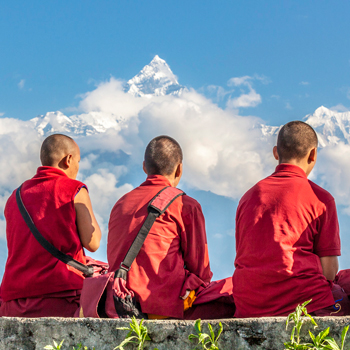Kathmandu Durbar Square – Things to know before visit
- Wednesday January 4, 2023
- 0
Kathmandu Durbar Square is the core of Kathmandu city, with many operating shops and restaurants. Kathmandu Durbar, Square-the biggest among other Durbar Squares (Patan and Bhaktapur), is a cultural and historical monument where several ancient temples are located, unique in their architecture.
In 1979, along with Patan and Bhaktapur Durbar Squares, Kathmandu Durbar Square was enlisted as a World Heritage Site by UNESCO. This architectural landmark was built around the 3rd century BC by the Licchavi Kings. They engaged Newar artisans and artists for the construction of most of the monuments in the square. Durbar Square has about 50 temples and monuments of various shapes, sizes, styles, and religions.
Everyday life in Kathmandu Durbar Square is in full swing; many locals pass through the square and drive on mopeds. There is always something new to spot, learn, and discover around every corner.
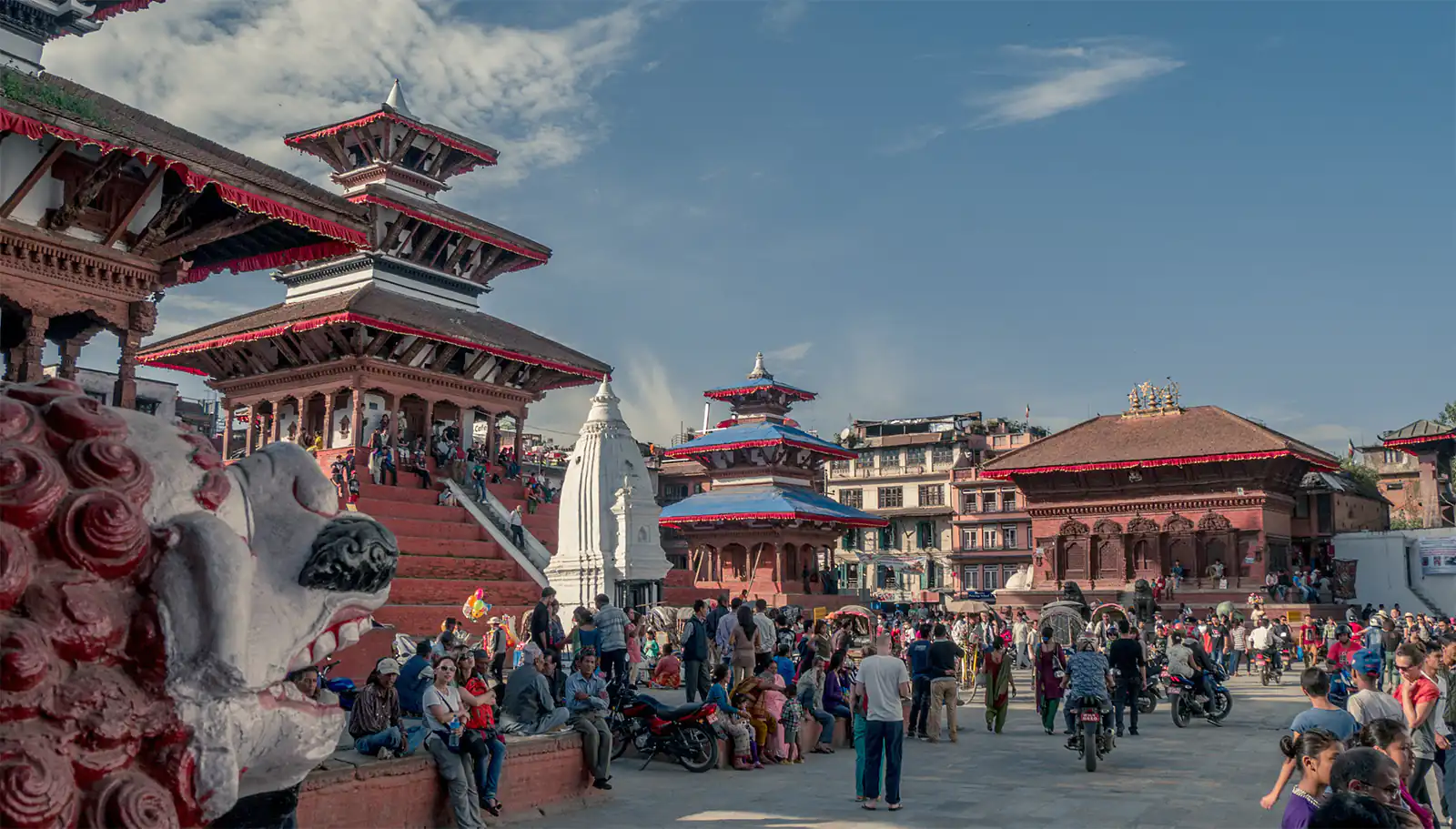
History of Kathmandu Durbar Square
The Licchavi dynasty laid the foundation for constructing Kathmandu Durbar Square around the 3rd century. Later, the Malla Dynasty and Shah Dynasty continued the expansion and beautification of the square. During the reign of King Ratna Malla, numerous royal palaces were built. However, Durbar Square only experienced its heyday under Prithvi Narayan Shah, who conquered the Kathmandu valley in 1769 and had numerous pagodas and palaces built on Durbar Square.
The square was the focal point for the then Royal family of Nepal. The coronation of the most beloved king of the Shah dynasty, Bir Bikram Shah, occurred in Kathmandu Durbar Square in 1975. The square also saw the crowning of the former king of the Shah dynasty, Gyanendra Bir Bikram Shah.
Why Kathmandu Durbar Square?
Kathmandu Durbar Square is notably one of the most vital sights of Kathmandu due to its central location in the old town. Due to the numerous buildings worth seeing and their history, a visit accompanied by a tour guide is highly recommended. In this way, you can explore the most exciting buildings and learn more about the creation of the square and its cultural significance for the local people.
The infrastructure of Kathmandu Durbar Square
The Kathmandu Durbar Square area consists of three related areas. To the south is Basantapur Square, once a royal elephant stable. The main area of Kathmandu Durbar Square is situated to the west. On the other hand, the second part of Durbar Square lies to the northeast, where you will find entry to the Hanuman Dhoka and other temples. From this open space extends north-easterly Makhan Tole, once the city’s main thoroughfare and still the most exciting street in Kathmandu.
Kathmandu Durbar Square Entrance Fee
Located just 1 km from Thamel- a tourist hub of Kathmandu, the Kathmandu Durbar Square entrance fee is NPR 1000 per person for foreign nationals and NPR 150 for SAARC nationals. A ticket booth in Basantapur collects the entrance fee, which is then used for the restoration and maintenance of the square.
How to get to Kathmandu Durbar Square?
This famous palace square is located northwest of the Nepalese capital. From the center of Kathmandu, you can reach Durbar Square via Swayambhu Marg, Gangalal Marg, and Durbar Marg. In good weather, you can cover a distance of 3.5 km in about 15 minutes.
Best time to visit Kathmandu Durbar Square
The preferable months to visit Kathmandu Durbar Square are October and November (dry season). The climate is mild, the air is clear, the visibility is excellent, and nature is luxuriant thanks to the monsoons. However, the visibility could be more optimal in December and January, and the temperatures are harsh. From February to April, the temperature is perfect, even if the visibility is a little poorer due to the dust. The rest of the year is unsuitable due to heat, dust, and monsoons.
You can take a leisurely walk through Kathmandu Durbar Square from 10 a.m. to 5 p.m. If you are more of a night person, wandering through the square will give you a glimpse of the local lifestyle. Local vendors, merchants, and small markets where you can buy souvenirs of various kinds fill Durbar Square.
Sights in Kathmandu Durbar Square
Kathmandu Durbar Square is now closed to traffic, making the square very pleasant to visit. In addition to the numerous buildings on the central square, the hustle and bustle of the people are exciting. Many believers make sacrifices to the respective gods in Durbar Square, hoping their prayers will be answered. Such offerings are to be respected due to the deep-rooted beliefs of the local people, and these offerings give you a deeper insight into the traditions of the land. The artistically decorated palaces and pagodas are just as fascinating as the significance associated with them.
The most essential and must-visit destinations of Kathmandu Durbar Square are:
1 – Hanuman Dhoka- The Royal Palace with Hanuman, the Monkey God
Right at the entry gate of the old royal palace in Durbar Square is an imposing statue of the monkey god Lord Hanuman. The faith in Lord Hanuman is evident in the numerous devotees who circle this statue counter-clockwise several times – a spectacle you will surely see when you visit Durbar Square. Two stone lions combined with the golden gate flanked the entrance, creating an imposing sight.
After passing through the golden gate, you will see the Narasingha statue, which depicts the Hindu god Vishnu in a bitter fight against a demon. In this case, Vishnu has been represented as a half lion and half man. Also worth seeing is the Audience Hall of the Kings, formerly used for various dance and theatre performances. The old royal palace on Durbar Square is one of Kathmandu’s most important historical buildings.
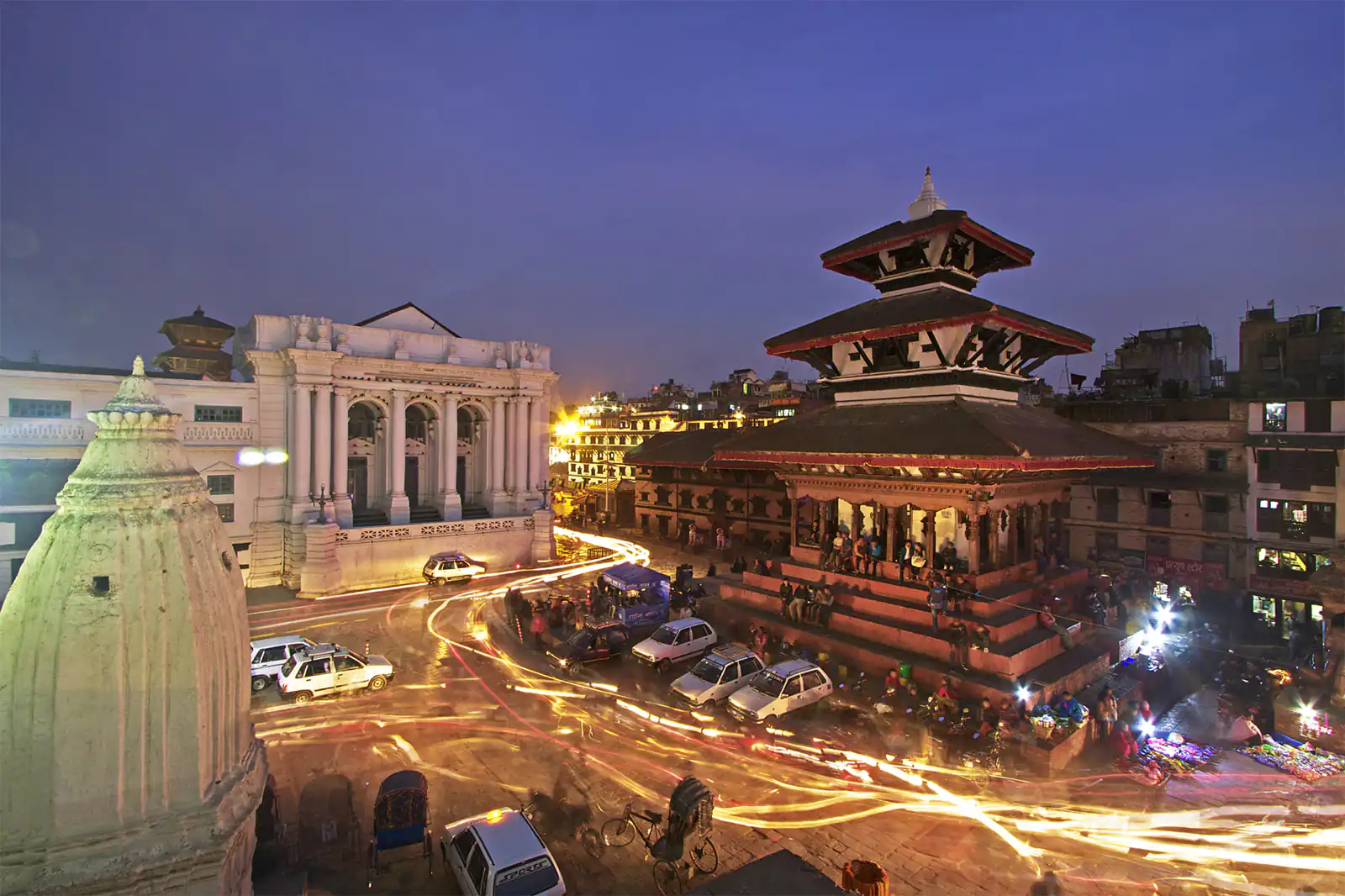
2 – Taleju Bhawani Temple
Taleju Bhawani temple, situated at a height of 35 meters, is open to the public once a year during the Mahanawami of the Dashain festival. King Mahendra Malla laid the temple’s foundation, while King Pratap Malla completed its construction.
According to many legends, the temple has the structure of a Yantra ( a mystical illustration containing magical powers). Goddess Taleju appeared disguised as a bee at the temple’s opening ceremony.
Former royals deeply believed in the goddess; not even the kings were allowed to build their palaces or structures around or near the temple.
During the 6th century, the Malla kings worshipped the Taleju goddess as their main deity. After the Malla dynasty, the Shah took over Kathmandu’s rule. Still, they also adopted the goddess as their royal deity to prove and cement their legitimacy on the throne. During the 2015 Nepal earthquake, most structures around the temple were destroyed except for the temple. People believe it is a miracle of the goddess. The temple has remained standing, albeit with some cracks.
The massive statue of stone lions guards the main gate to the temple. The main temple of Taleju consists of a golden statue of the goddess with ten arms with adjacent shrines to both Taleju Bhawani and Kumari, the living goddess of Nepal. There are 12 min temples around the main temple of Taleju and four other temples just below the main one.
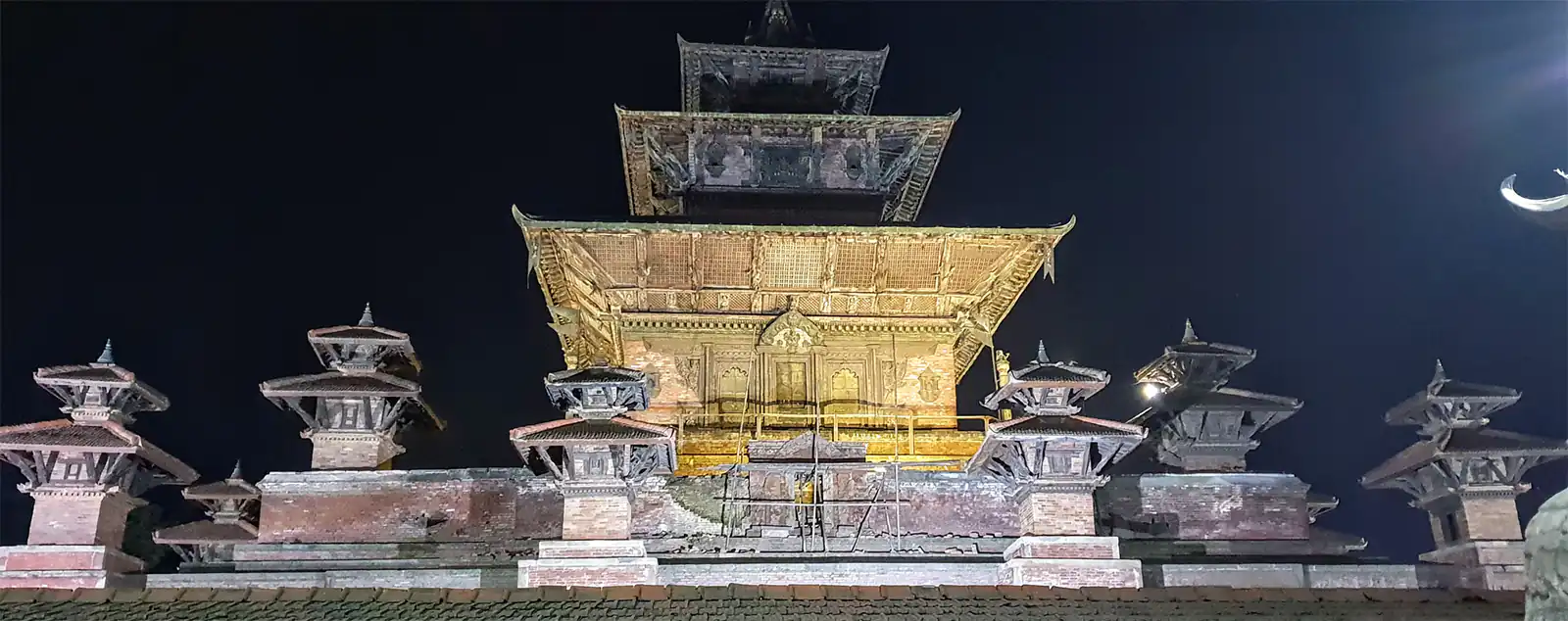
3 – Kumari Ghar (Residence of Goddess Kumari)
At the intersection of Kathmandu Durbar Square and Basantapur Square, you can see the three-storied red-bricked building with marvelous wood carvings. The building is the abode of Kumari- the earthly incarnation and only living goddess until she reverts to an ordinary girl upon reaching puberty. The word Kumari means Virgin. This goddess has the most significant influence on the entire pantheon of Kathmandu.
Kumari Ghar became an essential part of these places in 1757. The artisans decorated the home of the little goddess with intricate carvings. The inside of the building is named Kumari Chowk. It is a square-shaped enclosure surrounded by three floors of magnanimously carved wooden balconies – probably the most mystical courtyard in Nepal.
The passage to the courtyard of the Kumari temple is decorated with a casing with an intricately carved visor. From two sides, the palace is guarded by stone lions; they are also the identification mark of the palace.
Kumari Ghar is of great socio-religious importance and is built in the style of a Buddhist monastery. No other temple can exemplify Nepal’s living, breathing, and timeless religion, a wild mixture of Hinduism, Buddhism, and local traditions.
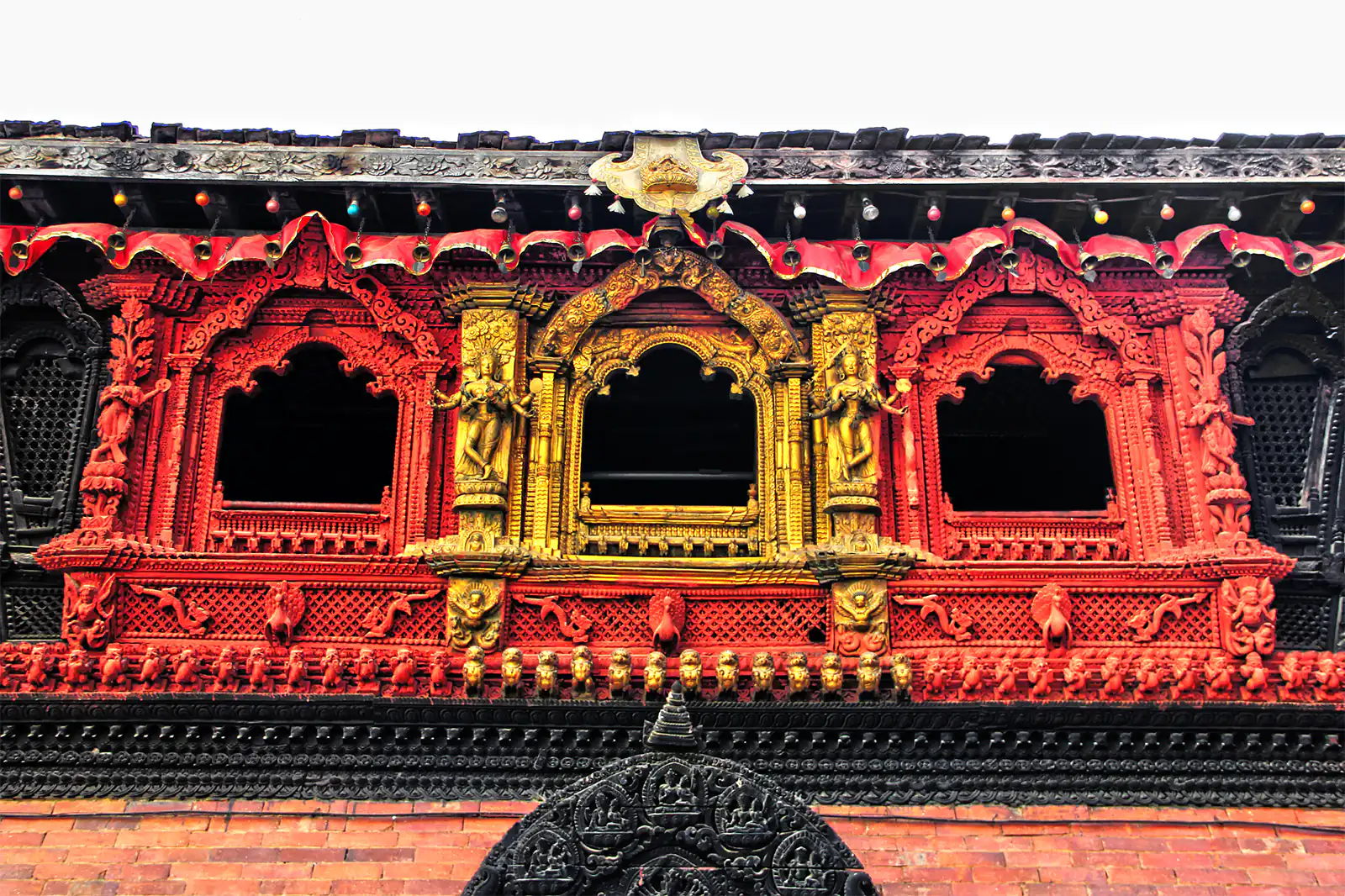
4 – Maju Dega
The other steps of this temple dedicated to Shiva are a pleasant place to while away some time, especially at sunrise and sunset. The nine-level basement is one of the city’s most popular meeting places.
From here, you can observe the exciting activity of the itinerant fruit and vegetable vendors, the comings and goings of taxis and rickshaws, and the comings and goings of tourists. The large three-roofed temple offers a majestic view of Durbar Square and the capital’s houses. The temple dates back to 1960, and inside you will find a lingam, a phallic symbol of Shiva.
5 – Jagannath temple
The infrastructure of Jagannath temple is an outstanding example of a multi-storied temple from the Malla Dynasty. The temple is dedicated to Lord Jagannath, one of the embodiments of the Hindu god Vishnu.
The temple is near the well-known Gopinath Mandir temple, dedicated to Lord Krishna. The construction of the Jagannath temple was concluded in 1562.
The two-story temple is erected on a three-tiered base. At the four corners of the base are four mini two-level temples, each also built in the standard Nepalese pagoda style. The inner section of the temple, known as Garba Griha, contains a stone image of Chatur Murti Vishnu. The stone image is a rare sculpture that combines four figures in one.
The roof braces have prominent erotic carvings with a robust sexual focus. The Jagannath temple is especially popular among tourists for this, and you can see a lot of onlookers around, flattering themselves with the hope of seeing the coveted sculptural images.
6 – Kasthamandap
Kasthamandap, which means shelter in a tree in Nepalese, is now one of Nepal’s most famous Hindu temples. Previously, merchants and wanderers who followed from Tibet to India used this three-level pagoda as their shelter.
Wandering people spent winter here anticipating spring and snowmelt on dangerous mountain passes. Later, in the second half of the 14th century, at the request of the king from the Shah dynasty, a shrine was erected in Kasthamandapa – a statue of Guru Gorakhnath. The shelter has turned into a temple visited by thousands of pilgrims. First, they are attracted by another local attraction – the footprints of the Guru Gorakhnath, who lived as a hermit.
The Kasthamandap temple was believed to be made from a single sal tree trunk, characterized by increased strength and resistance to environmental influences.
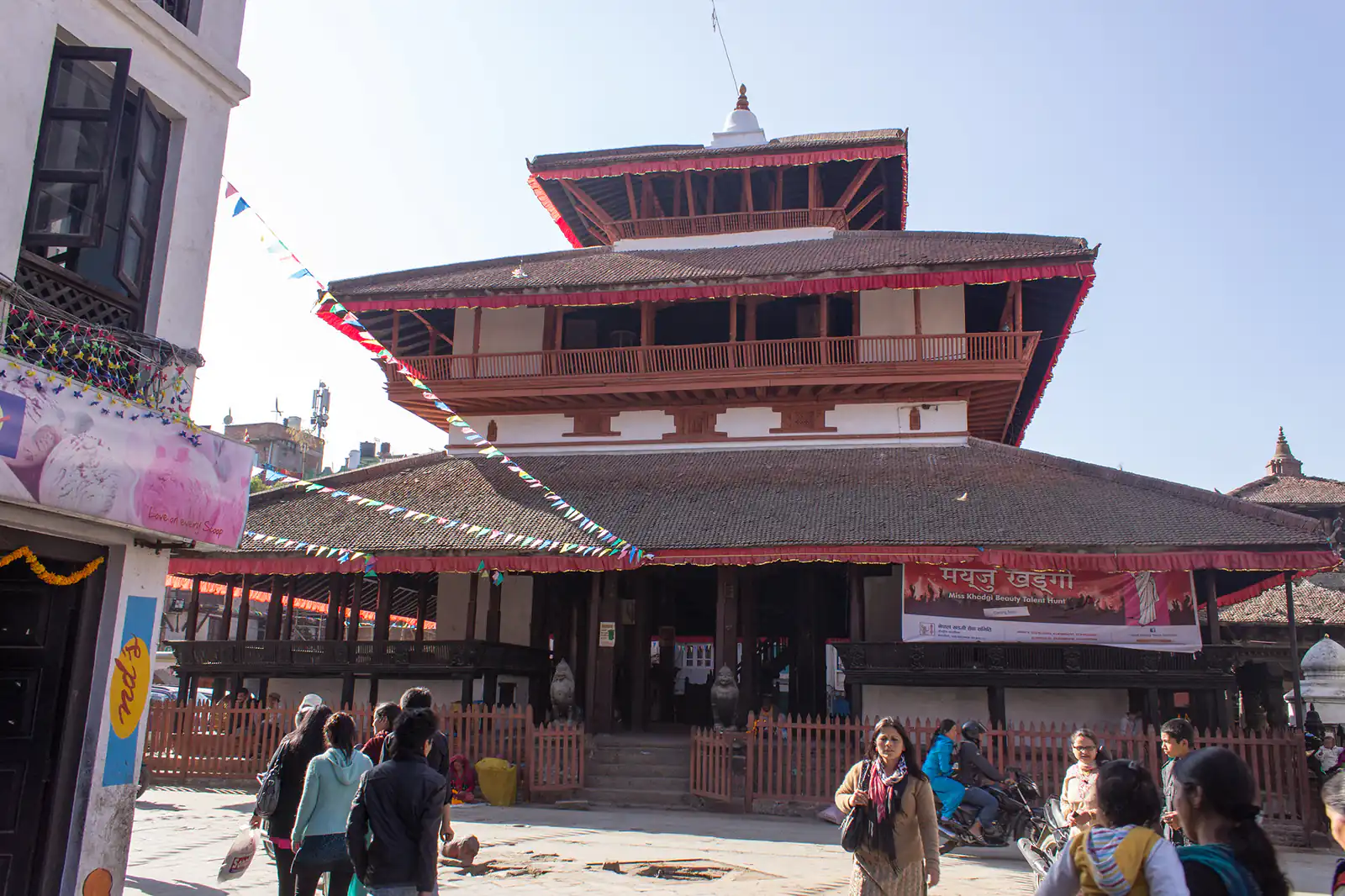
7 – Stone inscription
On the outer side of the white wall of the palace, facing the Vishnu temple is a long stone inscription in fifteen languages dedicated to the goddess Kalika. The inscription was made in 1664 at the behest of King Pratap Malla, known for his linguistic abilities. A Nepalese legend states that when someone manages to decipher all fifteen languages, milk will flow from the cinnamon in the center of the wall.
These are some of the strong heritage of Kathmandu Durbar Square. Apart from these legendary sites, the area has many more attractions, including temples, museums, malls, and local markets. Words are not sufficient to explain the attractions and beauty. So why wait? Pack your backpacks and fly to this culturally endowed site of Nepal.
8 – Gaddi Baithak
The Gaddi Baithak, constructed in neoclassical style during the rule of Prime Minister Chandra Shamsher, was used to give certificates of status to foreign guests. Numerous coronation ceremonies were held in this vital ceremony hall during the monarchy in the country.
Its false ceiling is made from metal. It is said that the glass used in the lamps hanging on the ceiling was brought from Belgium. On the right side of the Gaddi Baithak are pictures of 11 generations of Shah Dynasty kings. As you enter the central passage, you will see an artistic door made from wood gifted by the Burmese government.
The ground floor of this meeting hall is decorated with materials and details describing the transformation of the Nepal government from a monarch to a republic setting. The guns used by King Prithvi Narayan Shah during the country’s unification are also kept on this floor. Overall, the meeting hall is history that represents the revolution the country has seen over many years.
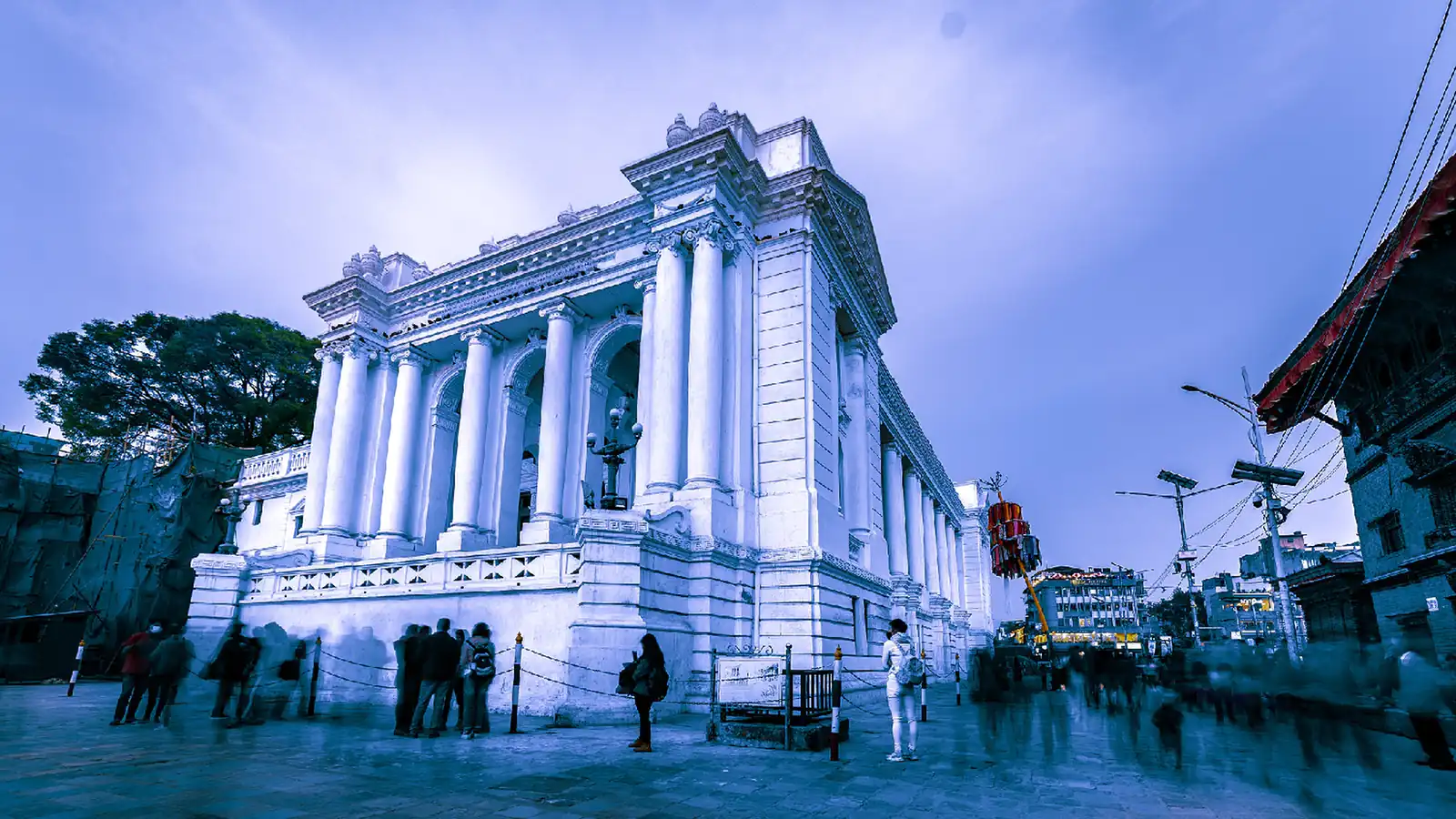
Accommodation near Kathmandu Durbar Square
1 – Durbar Square Backpackers Inn
Durbar Square Backpackers Inn is located in Kathmandu, 400 meters from Hanuman Dhoka Palace and Durbar Square. It features a bar, a restaurant, a shared lounge, and a 24-hour front desk.
Free Wi-Fi service is available throughout the hotel property. The Inn offers family rooms, with services including laundry, dry cleaning, ATM, press, car rental, safe, and concierge.
2 – Green House Lodge
Green House Lodge is located in Kathmandu, 200 meters from Hanuman Dhoka. It offers free Wi-Fi, a tour desk, ticket service, family rooms, and a terrace. The services available in the hotel include a 24-hour front desk, currency exchange, and 24-hour front desk.
3 – Little Nepal Inn
A 4-minute walk from Hanuman Dhoka Palace in Kathmandu, Little Nepal Inn is 400 meters from Kathmandu Durbar Square and 1.6 km from Swayambhu Stupa. It offers a garden, a terrace, and air-conditioned rooms. The tour desk at the Inn can help you organize any excursion you are planning. You can also order a transfer to make your trip more convenient.
Sport enthusiast guests will appreciate the fitness center of the Inn. A business center is provided for participants in business meetings. For the convenience of the guests with disabilities, the elevator is situated in the hotel, taking you to the upper floors. Laundry, dry cleaning, ATM, press, and safe are also at guests’ disposal.
4 – Harati Manor Inn
Located in Kathmandu, this homestead is 100 meters from Durbar Square, a 1-minute walk from Hanuman Dhoka Palace, and 1.7 km from Swoyambhunath Temple Centre. It has air-conditioned rooms with free Wi-Fi and a bar.
5 – World Heritage Hotel and Apartments
World Heritage Hotel Apartments is located in the famous Durbar Square, 2 km from Thamel and the Royal Palace. It offers a free airport shuttle and free Wi-Fi throughout the hotel. Suitable for a budget holiday, World Heritage Hotel and Apartments offers laundry, dry cleaning, ironing, press, car rental, safe deposit box, and concierge.
